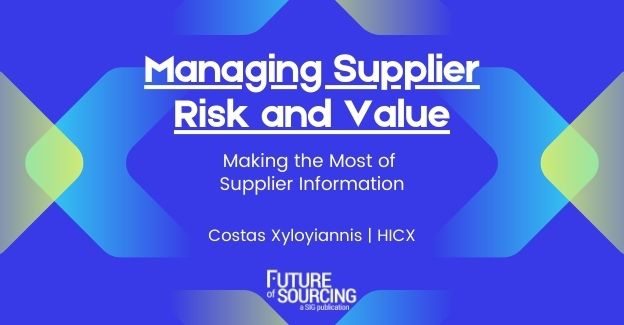Managing supplier information and screening for ethical business practices is expected by regulators and consumers says Costas Xyloyiannis, CEO of HICX. Having good supplier management processes in place can help organizations stay ahead of regulators to avoid costly fines, minimize reputational damage and reduce friction in the buyer-supplier relationship.
What was once nice-to-have information has now been defined by law. As concern grows around modern slavery, GDPR, conflict minerals and climate change, governments and related third parties are demanding – with regulatory backing – that businesses ensure ethical supply chains.
To mitigate regulatory and reputational cost, organizations need robust, accurate and extensive supplier information. For those with large complex supply chains, this is no mean feat. But apart from alleviating risk, getting your supplier information ducks in a row can also drive value.
So, how can organizations take full advantage of the information their suppliers provide?
Know What’s at Stake
In addition to organizations being able to provide certain supplier information, they must also fully understand it. The penalties for not getting this right can range from fines running into millions of pounds or dollars to exclusion from bidding for government contracts.
Another consideration is that employees and consumers are starting to move away from companies that they consider unprincipled. A study by Deloitte found that 45% of Gen Z consumers stopped purchasing certain brands because of ethical or sustainability concerns. As this stakeholder pressure continues, so does reputational risk for companies that don’t comply.
Equally, these stakeholders favor brands that make an effort to be conscientious. Moral commitments, such as exclusively using biodegradable packaging and supporting suppliers that pay a living wage, are at the heart of many marketing strategies.
A more internally focused opportunity is managing the value that suppliers generate for the lifetime of the relationship. To achieve this, organizations must have good supplier management practices in place that help them to receive relevant information and recognize where more may be required.
Gather the Right Information
Supplier master data, the foundation on which all supplier-related information can be built, must be well managed. It’s crucial that organizations gather the right information at the beginning of the relationship, before keeping it updated. This must be done in a structured and controlled manner.
The three types of supplier information that are subject to this closer scrutiny are basic business, performance and risk management material. Mostly collected before they start collaborating, the first category relates to what the supplier does and items they supply, as well as contact and payment details. It also includes prices, references, certifications and the signed contract.
Performance information is collected throughout the partnership. As the name suggests, it applies to production and output information, as well as factors like KPIs, customer satisfaction, service-level information, delivery, quality, contract compliance and progress reports.
Lastly, risk management information covers both the supplier’s financial situation and their business beliefs. This includes information on their stance and practices around issues such as modern slavery, the environment, health and safety and human rights issues.
The goal is to receive and capture superior quality information, so that it can be assessed and put to good use.
Step Into the Supplier’s Shoes
Considering that organizations are dependent upon suppliers for this information, having healthy supplier partnerships in place is an absolute necessity. Being more supplier-centric begins with prioritizing a single source of truth in supplier data, and then removing all relationship friction.
One such point of friction for suppliers is the process of providing information. The way in which these requests are communicated at the outset is often counterproductive. It’s not unusual for suppliers to be inundated with a steady stream of requests that are complicated to complete.
In most cases, information must be maintained across multiple portals, each with unique login details. The systems and processes suppliers use to respond, are rarely designed with their experience in mind. Nor are the questionnaires, which don’t always marry certain details about the supplier with the information being mined.
In reality, all suppliers want is to get paid and renew their contracts. So, when providing information is confusing and time consuming, they treat the task as a tick-box exercise, rather than working together with the organization as partners towards a common goal.
Request Information by Segments
Undoubtedly, offering suppliers the most engaging and relevant experience empowers them to provide the best possible information. One way to achieve this is to use a single source of truth in supplier data to segment them into groups. Once clustered according to certain filters – for example, by country, category and spend – the organization can drive an efficient workflow that leads to the right information from each recipient group. When managing risk, this is crucial.
Incidentally, it also helps to craft a better supplier experience. By removing communication bugbears, suppliers can provide better information more often, in addition to doing great work. This information further drives a healthy supplier experience, and so the cycle continues.
While managing suppliers by segments is not new in procurement, there’s an opportunity for the tactic to be deployed in a modern context. In recent years, the mandate of the function has progressed from being purely transactional to more strategic. As the function evolves, it’s also becoming more digital. Encouragingly, procurement teams in leading organizations are starting to embrace contemporary technology that supports more agile and resilient supplier management.
The requirement for buyers to manage their supplier information is likely to continue growing, as are the associated regulatory and reputational exposures. But with the right mindsets, processes and platforms in place, organizations can obtain robust supplier information. It is from this foundation that the risk and value suppliers present can be managed.









